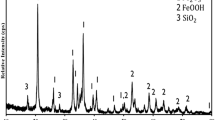Abstract
In this work, the experimental performance of sorption-enhanced reforming using limestone as bed material, which is used in raw iron production, is presented. Steam gasification of solid biomass by sorption-enhanced reforming process (SER) leads to product gas with high hydrogen content and low tar content. The product gas can be used for a wide range of applications. This includes heat and electricity production, synthetic fuels, and other downstream processes. On the basis of dual fluidized bed steam gasification of biomass (dual fluid gasification), a reactive bed material is used to enhance the formation of hydrogen. Blast furnaces in iron production operate on the principle of chemical reduction, whereby carbon monoxide and hydrogen reduce the iron to its elemental form. The present paper summarizes the results of an experimental investigation into SER with limestone usually used as a part of iron production. The illustrated results reflect the operation of sorption-enhanced reforming within an experimental facility at the Vienna University of Technology.






Similar content being viewed by others
Abbreviations
- DFB:
-
Dual fluidized bed
- Nm3 :
-
Cubic meters according to standard conditions for pressure and temperature (0 °C, 1.013 bar)
- wt.-%:
-
Percentage by weight
- vol.-%:
-
Percentage by volume
- SER:
-
Sorption-enhanced reforming
- db:
-
Dry basis
References
Mueller S (2013) Hydrogen from biomass for industry—industrial application of hydrogen production based on dual fluid gasification. Dissertation, Vienna University of Technology
Koppatz S, Mueller S, Schmid J (2012) Future energy technology. Vienna University of Technology, ISBN 978-3-9502754-3-8
Soukup G, Pfeifer C, Kreuzeder A, Hofbauer H (2009) In situ CO2 capture in a dual fluidized bed biomass steam gasifier—bed material and fuel variation. Chem Eng Technol 32(3):348–354. doi:10.1002/ceat.200800559
Koppatz S, Schmid J, Pfeifer C, Hofbauer H (2012) The effect of bed particle inventories with different particle sizes in a dual fluidized bed pilot plant for biomass steam gasification. Ind Eng Chem Res 51(31):10492–10502. doi:10.1021/ie202353b
Pfeifer C, Puchner B, Hofbauer H (2009) Comparison of dual fluidized bed steam gasification of biomass with and without selective transport of CO2. Chem Eng Sci 64(23):5073–5083. doi:10.1016/j.ces.2009.08.014
Koppatz S, Pfeifer C, Rauch R, Hofbauer H, Marquard-Moellenstedt T, Specht M (2009) H2 rich product gas by steam gasification of biomass with in situ CO2 absorption in a dual fluidized bed system of 8MW fuel input. Fuel Process Technol 90(7–8):914–921. doi:10.1016/j.fuproc.2009.03.016
Hofbauer H, Veronik G, Fleck T, Rauch R (1997) The FICB—gasification process. In: Bridgewater A (ed) Developments in thermochemical biomass conversion, vol 1. Kluwer, London
Hofbauer H, Loeffler G, Kaiser S, Fercher E, Tremmel H (2002) Six years experience with the FICB-gasification process. In: 12th conference on biomass and bioenergy, Amsterdam
Koppatz S, Pfeifer C, Hofbauer H (2011) Comparison of the performance behavior of silica sand and olivine in a dual fluidized bed reactor system for steam gasification of biomass at pilot plant scale. Chem Eng J 175:468–483. doi:10.1016/j.cej.2011.09.071
Schmid J, Wolfesberger U, Koppatz S, Pfeifer C, Hofbauer H (2012) Variation of feedstock in a dual fluidized bed steam gasifier—influence on product gas, tar content, and composition. Environ Prog Sust Energ 31(2):205–215. doi:10.1002/ep.11607
Standardization ECF (2013) Tests for mechanical and physical properties of aggregates. Part 2: methods for the determination of resistance to fragmentation, vol EN 1097–2
Sobotka C (2013) Bestimmung der CO2 Aufnahmekapazität von vier Kalksorten mittels TG Analyse STA 449 F3 inkl. Wasserverdampfer. Report, University of Leoben, Department of Nonferrous Metallurygy, Leoben
Pfeifer C, Puchner B, Hofbauer H (2007) In-situ CO2-absorption in a dual fluidized bed biomass gasifier to produce a hydrogen rich syngas. Int J Chem React Eng 5(1):1542–6580. doi:10.2202/1542-6580.1395
Neeft J.P.A. et al. (1999) Guideline for sampling an analysis of tar and particles in biomass producer gas. In: Progress in thermochemical biomass conversion, pp 162–175
Hawthorne C et al (2012) Operation and results of a 200-Kwth dual fluidized bed pilot plant gasifier with adsorption-enhanced reforming. Biomass Convers Biorefinery 2(3):217–227. doi:10.1007/s13399-012-0053-3
Schmid J, Proell T, Kitzler H, Pfeifer C, Hofbauer H (2012) Cold flow model investigations of the countercurrent flow of a dual circulating fluidized bed gasifier. Biomass Convers Biorefinery 2(3):229–244. doi:10.1007/s13399-012-0035-5
Hofbauer H, Schmid J, Fuchs J (2012) Cold flow model study of an advanced dual fluid bed system for fuel conversion. In: 3rd international symposium on gasification and its application (iSGA-3), 2012, Vancouver, British Columbia, Canada
Acknowledgments
The present work is part of the ERBA project, which is being conducted within the “New Energies 2020” research program funded by the Austrian Climate and Energy Fund and processed by the Austrian Research Promotion Agency (FFG). The work has been accomplished in cooperation with voestalpine Stahl GmbH and voestalpine Stahl Donawitz GmbH. Martina Poppenwimmer, Hugo Stocker, and Thomas Bürgler from voestalpine deserve to be mentioned as well as Hannes Kitzler, Veronika Wilk, and Stefan Kern for their good collaboration and their assistance during the experiment.
Author information
Authors and Affiliations
Corresponding author
Rights and permissions
About this article
Cite this article
Diem, R., Mueller, S., Fuchs, M. et al. Sorption-enhanced reforming with limestone from iron production. Biomass Conv. Bioref. 5, 95–102 (2015). https://doi.org/10.1007/s13399-014-0149-z
Received:
Revised:
Accepted:
Published:
Issue Date:
DOI: https://doi.org/10.1007/s13399-014-0149-z




